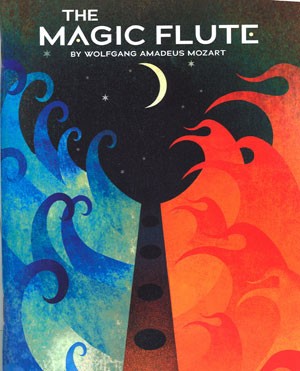The first thing to remember about “”The Magic Flute”” is that it’s an opera. That is, no matter how delightful it might be, and no matter how sparkling its score, it’s still three hours of people standing on a stage singing opera. Unrelenting, unapologetic opera. If you can get past that, it’s a lovely way to spend an evening.
That said, the Arizona Opera production of Wolfgang Amadeus Mozart’s 1791 classic ought to delight even non-operagoers. Its frankly strange story is a long way from the wacky screwball farces you usually find in opera. (There’s not as much distance as you might think between “”The Marriage of Figaro”” and “”I Love Lucy.””)
In the opening scene, a fearsome serpent is chasing the prince Tamino. He is rescued by three attendants of the Queen of the Night, who dramatically descends on a camel and introduces herself.
The queen commands the grateful Tamino – in an aria justly admired as one of the most difficult to sing in the history of opera – to rescue her daughter, the princess Pamina (Hanan Allatar), who has been kidnapped by the evil Sarastro. She gives Tamino a magic flute and a chime of bells to protect himself with. So Tamino sets forth, accompanied by the lovable rogue Papageno (Joshua Hopkins), a bird-catcher.
“”The Magic Flute””
Arizona Opera
4 stars
From here, however, the story gets increasingly bizarre. When Sarastro’s brutal servant drags Pamina before Sarastro, the suddenly genial old man orders the servant beaten for his cruelty. Suddenly Sarastro and his secret cabal of mysterious, hooded old men become the story’s putative heroes, and the Queen of the Night and her attendants become the villains. (A hard thing for modern viewers to swallow, given that Sarastro and his men are inclined to lecturing on the foolishness of women.)
Tamino and Papageno embark on a series of difficult labors to prove their worthiness to join Sarastro’s cabal. They mostly involve “”not speaking,”” which results in the amusing spectacle of two opera singers hollering, “”Don’t say a word!”” at each other.
From here, things get stranger and stranger. Much time is spent trying to find Papageno a wife whose name, appropriately enough, turns out to be Papagena. The story begins to take on the opaque gorgeousness of a stained-glass window; you’re sure all of it has meaning, but you’re not sure what it is.
Of course, we can’t blame this crazy business on Mozart -it’d be more accurate to blame Emanuel Schikaneder, who wrote the libretto. Both were Masons, and there’s certainly a touch of Masonic craziness about the Sarastro scenes.
The sets are beautiful and match the intriguing weirdness of the story, particularly in the “”pyramid”” motif that repeats throughout the opera. The performances are wonderful throughout, especially Hopkins, who has a breathtaking voice. Jason Ferrante is also funny as Sarastro’s wicked servant, Monostatos. By far the most impressive moment was the Queen of the Night’s descent onto the stage; a moment that clearly won her the audience’s heart, and no amount of second-act shenanigans could take it away.
By the opera’s second half- judging from the old couple taking turns snoring to my left and the restless pre-teen to my right- one could tell that the story had lost the audience, even if the music and the action kept its attention. How could they not?
Film critic David Thomson once observed of the old film noir “”The Big Sleep”” that audiences didn’t seem to care that the story made no sense as long as the actors kept acting like they were in an exciting movie, and much the same goes for “”The Magic Flute.””









